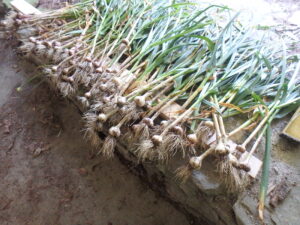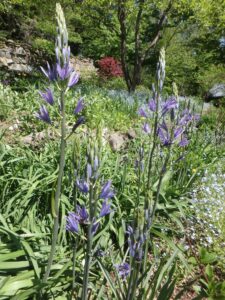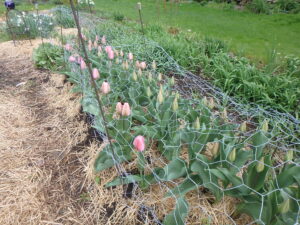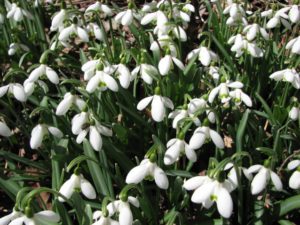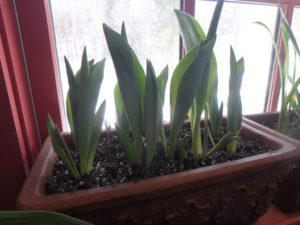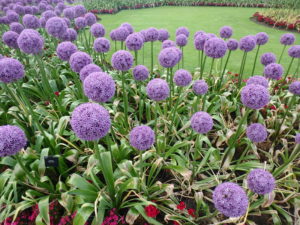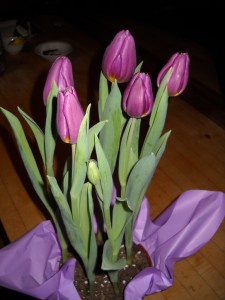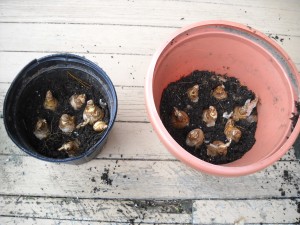Planting in October
For some of us, planting time is long past – but not for me. I am always busy in the fall, planting everything I can. It is almost time to plant garlic, which is my easiest crop of all. And I’ll soon be planting spring bulbs, both in the ground and in pots for forcing. Now is the time to purchase bulbs and seed garlic if you don’t have any garlic of your own to plant.
Garlic is by far my least labor-intensive vegetable crop. I start by weeding out one of my wide, mounded beds and loosening the soil well. I use my CobraHead Weeder to loosen the soil and to make shallow furrows 8 to 12 inches apart. I sprinkle some granular organic fertilizer in the furrow, and run my hand tool through the soil again to work in the fertilizer.
Each garlic bulb has 4 to 8 cloves, which need to be separated for planting. Plant them 3- to 4-inches apart and about 3-inches deep. Cover and press down the soil over them, watering if the soil is dry. Lastly mulch with a thick layer of straw or mulch hay. I use 8 to 12 inches of loose straw which gets packed down to 4 inches by the winter snows. Garlic will grow up through the mulch, but most weeds will not.
To learn more about garlic, you might want to read “The Garlic Companion: Recipes, Crafts, Preservation Techniques and Simple Ways to Grow Your Own” by Kristin Graves. (Storey Publishing, 2024). A nice book, it taught me few things and has recipes I will try. Kristin is a Canadian farmer who grows 75,000 bulbs of garlic each year, so she knows her stuff!
I also plant a lot of spring-blooming bulb flowers in pots for early blossoms indoors and as gifts to friends. I mix used planting mix from summer pots with good compost and plant daffodils and tulips in planters and my window box. You can pack the bulbs close together in pots – and they need only a couple of inches of soil mix above and below them. Store them in a cool, dark place – 35 to 50 degrees is best. But even a cold garage will work if they can establish roots early and then snooze a little if the soil freezes.
Daffodils take about 12 weeks of dormancy before they should be brought into the warmth of the house, but tulips do better with 16 weeks. Little things like crocus can be forced in 8 to 10 weeks. Be sure to label them with the date planted and variety. Water lightly once a month. My favorites are Tête-à-Tête daffodils – small early daffodils in bright yellow. I pack 4 bulbs into a 4-inch pot and share them in February and March when friends need a pick-me-up.
This is also the time to plant bulbs outdoors for spring. Most bulbs like a sunny location with well-drained soil, but you can also plant bulbs under deciduous trees if they get enough sun filtered through them, or before they leaf out. If you have a site with good sun but moist soil, there a few bulbs that will work. “Thalia” is a white blossomed, late-blooming daffodil that does well even in fairly wet soil.
Camassia is a bulb plant that prefers damp soil. It produces blue to purple flowers on tall stems – up to 3 feet tall with hundreds of small blossoms. A good sandy loam is best, but it will do fine in any sunny soil that stays moist during the bloom season. It is not of interest to deer, and will keep coming back for years if happy where you plant it.
Tulips, on the other hand are delicious to deer as flowers, and to rodents as bulbs. During World War II some Dutch bulb growers avoided starvation by eating their tulip bulbs, though I have never been that hungry! To foil the deer I plant 100 tulips in my vegetable garden most years and surround and cover the bed with chicken wire. I grow them as annuals, pulling the bulbs after they bloom.
Planting 100 bulbs of the same kind means they all bloom at about the same time. So I cut them and put flowers in quart jars and deliver to friends, neighbors, the elderly and the infirm. It is so much fun to do so! Try it.
Over the years I have planted hundreds, nay, thousands of daffodil bulbs. Most survive and thrive – nothing eats them. I have a patch of daffies from bulbs I dug up at my boyhood home in the early 1970’s – some 50 years ago. To keep them producing well it’s good to top-dress the soil with ‘”bulb booster” or a good slow-release organic fertilizer- either now, or in the spring.
To plant 25 daffodils I dig a hole about 6 inches deep, a couple of feet long and about 18-inches across. I loosen up the soil in the bottom with my CobraHead Weeder, a single-tine cultivator. I sprinkle a cup or so of organic fertilizer in the bottom, and work it in, working in a bucket of compost, too. Then I plant the bulbs, pointy end up. The directions may tell you to plant daffodils 6-inches apart, but I tend to plant them 3- or 4-inches apart and they do fine. I press them down into the loose soil.
Lastly, I refill the hole. If the soil is full of rocks, I remove them. If it is sandy or full of clay, I mix the soil I use to refill the hole with a 50-50 mix of good compost and soil.
So take a sunny afternoon and go plant bulbs – either outdoors, or in pots for forcing. It’ll be something to look forward to all winter.
Henry is writing just one article per month. You can reach him at henry.homeyer@comcast.net
Gardening: The Slowest of the Performing Arts
March has been ferocious. None of this “In like a lion, out like a lamb” business. The entire month has been a Tyrannosaurus Rex, if you ask me. I’ve done more roof-shoveling this month than I usually do in a year. My poor snowdrops, usually showing me their noses in early March, are still deep in snow. Sigh. But spring will come. It always does.
Snowdrops, my harbinger of spring, are best planted on a south-facing hillside. That way the snow melts off early, and allows them to push up through the frozen soil. Unlike tulips, their little white flowers look downward, so one must bend over and tip the blossoms up to see inside, which is always the most interesting view of a flower – all those stamens and pistils.
My snowdrops have multiplied over the decades. I don’t know if they move by seed, or if little rodents dig them up and move them around. I suspect it is by seed since they tend to move downhill into the lawn. Fortunately, they get all the sunshine they need to re-charge their batteries by the time I’m ready to mow the lawn. Daffodil leaves, on the other hand, don’t dry up until July, so I don’t plant them in the lawn.
Glory of the snow (Chionodaxa lucilae) is another small early bulb plant that will appear as soon as my snow disappears, and it has multiplied nicely over the years, too. I have it light blue, white and pink. Unlike snowdrops, the blossoms open with their faces up towards the sun – and us.
Scilla siberica, or squill, comes out just a few days after my glory of the snow and has a very intense purple color. Just a couple of inches tall, these small beauties look down, like the snowdrops. These do not multiply quickly, though their clumps or clusters do get more robust over time.
Bright yellow, school bus yellow, I associate with daffodils, and I have plenty of those that bloom in April and May. But before even the earliest are some short yellow blossoms of winter aconite (Eranthis hyemalis). I just learned that they are related to buttercups, which makes sense to me, given their color and flower shape.
Aconite are marginally hardy for me in Zone 4, but last spring I had many tiny ones, clearly first-year plants that developed from seed. I wonder if they will return and bloom for me this year. Such questions will get me outside and in the garden every day, should I ever get old and frail.
Many gardeners have given up on tulips because they are so tasty: to rodents that eat the bulbs, and to deer that consume the buds, blossoms and leaves. Not only that, most gardeners find tulips don’t return, year after year. I think of them as annuals since in year two I get half the number of blossoms I did in year one, and then only half of those come back to bloom in year three. No matter, I love them and plant them.
There are solutions to the tulip dilemma. First, I plant plenty each fall in clay pots and store them in my cold basement. Then, after 4 months of cold storage, I bring the pots into the warmth of the house and they bloom on the window sill. Right now I have some budding up, getting ready to bloom.
At the end of President Clinton’s tenure in the White House I got to interview the White House gardener, Dale Haney. The gardeners had just planted many thousand tulips, a pink one called Hilary Rodham Clinton! I always wondered if the Bush family asked the name of that one, and how President Bush felt about seeing Hilary tulips outside the Oval Office windows, waving at him in the breeze.
.
The White House grounds, I observed, were not only served by many gardeners, but occupied by many large, fat, lazy gray squirrels. I asked Mr. Haney about them. First, he explained, that our tax dollars paid for hundreds of pounds of sunflower seeds to feed the squirrels. A well-fed squirrel is less likely to dig up tulips, he said.
He also explained that the gardeners laid down chicken wire above the bulbs – but an inch or two below the soil surface. Thus if an unusually ambitious squirrel decided to lunch on a Hilary, it would be thwarted by the screening. I’ve tried that, but it’s a lot of work – and my little corgi and two aging cats seem to deter squirrels from digging up any tulips I plant outdoors.
Alliums are bulb plants that vary considerably in size and look according to the species or variety. They’re in the onion family, so not eaten by critters. I was amazed by all the diversity I saw last spring in London at the Chelsea Flower Show, and at Kew Gardens.
I’ve always had a few big ones outdoors, but last fall I planted some in pots to force indoors, as one spectacular variety I simply had to have, Allium schubertii, is only hardy to Zone 6 and would not survive outdoors here. I bought plenty of others that are hardy here in Zone 4 and can’t wait to see them perform.
Gardening – indoors or out – really is the slowest of the performing arts. Plant something, wait, hope. The anticipation, for me, is almost as important as the performance.
Henry is a UNH Master Gardener and the author of 4 gardening books. Reach him by e-mail at henry.homeyer@comcast.net.
Tulips
Winter is here and our flower gardens are, for the moment, just memories. But potted tulips in reds, purples and yellows are available at florist shops and grocery stores to brighten our spirits and grace our tables. For about $10 you, too, can have a few tulips in a 6-inch pot. If you keep them lightly watered and not too hot, they should last for at least a week.
On a recent rainy, slushy day I dug out a book on tulips that I’d been given years ago and never read, The Tulip by Anna Pavord. She is an excellent writer, but a bit obsessive when it comes to tulips. She follows the history of tulips in Europe from its origins in Turkey and Iran, describing in detail the kinds of tulips and who grew them. She even mentioned one sultan who had 920 gardeners!
The book continues through the tulip fads of Europe and the well known tulip craze in Holland when certain tulips sold at auction for the equivalent of 10 years income for a tradesman. I love tulips, but I’d certainly never be tempted to bet the ranch on being able to propagate and sell rare tulip bulbs. The Dutch particularly loved striped tulips. The best ones were actually created by a virus that was carried from plant to plant by aphids, causing some (but not all) to mutate.
The book has a nice summary of the kinds of tulips available: there are 15 “divisions” or groups of tulips, including the simple ones akin to the wild varieties originally from Persia or the East. It also has 50 pages of description of the common named varieties. This is truly a book for tulip-obsessive gardeners, and I admit I skipped over long sections of it. At 438 pages it would be a challenge for all but the most avid tulip lover to read in its entirety.
As I read through the descriptions of the divisions of tulips, I realized that I have at least tried growing of a few of each kind at some point in the past 30 years. I have settled into growing the tallest, most dramatic ones and treating them as annuals. My favorite is a creamy colored one called ‘Maureen’. I’ve read that it is a tetraploid, meaning that it has been somehow manipulated to have twice the number of genes as normal, so it grows bigger than most– 28 to 32 inches tall. This is not a GMO (genetically modified organism), but a hybrid developed in the 1950’s.
In my experience tulips run down hill with time: if I plant 100 bulbs in a cluster, as I like to, I expect to get 90 or more blossoms, come spring. But the second year I might get just 50, and half that the following year. So I re-plant in the same bed each year, and don’t worry about past year’s bulbs. After bloom season, I grow annual cutting flowers in that same bed, mainly zinnias.
Of the shorter tulips, I’ve found that the division called Kaufmanniana is very pleasing. These are short, stocky red tulips that are much more perennial than the big ones. The division called Greigii is another low, simple group. Those that I grew were yellow with stripes, and lasted several years before they disappeared. Tulip bulbs, as you may know, are attractive and tasty to rodents of all kinds and the stems and flowers have been providing lunch for deer forever.
My gardening grandfather, John Lenat (1885-1968) was a very friendly character, who spoke to everyone he met – in the line at the grocery store, at the bank or walking down the road. Along with a love for flowers and tomatoes, I inherited that – to my advantage. Many years ago I was standing in line at the local food Coop and, as Grampy would have done, I struck up a conversation with a woman who had selected some freshly cut tulips to buy.
That woman in line taught me a great trick. She explained that tulips can be persuaded to stay in bud rather than opening up (and soon dropping their petals) by dropping 3 pennies in the vase of water. Actually, this woman was someone who remembered WW II when, in 1943, pennies were made of steel and clad with zinc. So she said, “Drop three copper pennies in the vase.” Since I collected pennies as a boy, I knew about the zinc penny. But anyhow, I tried it, and it works! I don’t know what the copper does, but I’ve had tulips stay in bud for a week or more in the vase until they finally dropped their petals all at once.
Whether you are enjoying cut tulips or live tulips growing in a pot, keeping them cool always prolongs their bloom time. If you keep your house at 70 degrees, try to find a cooler location for them. Or put them in the fridge or in an unheated entryway at night.
Each fall I plant tulips in containers and store them in a cool dark place. Around the first of March I bring the tulips up to the warmth of the house and they soon blossom – long before my outdoor tulips.
So go buy some tulips. They’ll help you through the gloomy days of winter.
Henry Homeyer can be reached at PO Box 364, Cornish Flat, NH 03746 or on-line at henry.homeyer@comcast .net. His website is www.henryhomeyer.com.
Forcing Bulbs for Spring
Winters can be hard on many gardeners: short dark days, icy roads and little to do in the garden. Yes, I like to snow shoe and cross country ski, but it doesn’t replace gardening. I water my houseplants (and occasionally talk to them), but they are weak substitutes for the real thing. By the time mud season comes in March, I want blooming flowers to brighten my life.
I get early blossoms in two ways: First, I have early bulb plants outdoors, including hundreds of snowdrops that bloom in March. And second, I force bulbs to bloom early indoors. Now is the time to plant bulbs so that they will bloom when we need them the most – a month or two before they bloom outdoors.
In order to prepare bulbs for early blooming indoors, you will need a place to store them that is cold, but not as cold as the outdoors. Despite global warming, I still see minus 20 every winter, even if for only a few days. Bulbs planted in the ground have some protection against the cold, but if you were to plant bulbs in pots and leave them outside, the extreme temperatures would kill most. Bulbs left in a cool basement or garage will do just fine.
Ideally temperatures for bulbs used for forcing will be between 33 and 50, though a few days of below freezing temperatures is not be a problem (my basement often goes a below freezing). Left in a warm location, the bulbs will grow green tops – but not blossoms.
Bulbs can be planted for forcing in pots or window boxes. Good drainage is important to avoid rotting the bulbs, so don’t plant them in ordinary garden soil. I think an ideal mix is one that has half compost and half potting mix. I want the mix to be lightly moist at planting time, but not soggy. Once a month I check the pots to make sure the soil is not bone dry; if it is, I water lightly.
When planting daffodils or tulips outdoors, I plant them 6-8 inches deep but that is not necessary when planting bulbs in pots. Depending on the type of container I use, the pointy tips of my bulbs may be just an inch or two below the soil surface. And I plant them shoulder-to-shoulder, crowding in as many bulbs as possible in the container. After they finish blooming in the spring I will plant the bulbs outside, but for now they have everything they need to bloom inside the house.
Timing is key to success with forced bulbs. Little bulbs like crocus need just 8-10 weeks of dormancy, but daffodils need 12 weeks, and tulips do better with more, up to 16 weeks. Choose bulbs that are marked “Good for Forcing” or that are listed as “early” rather than mid-season or late. If you are selecting bulbs now, make sure that they are still firm, not papery and dried out. And if you see them with long green sprouts, pass them by.
Beware of mice. If you have mice, they will eat your tulips unless you exclude them somehow – with wire mesh screening, for example. Daffodils are lightly poisonous, so mice don’t eat them.
You can maximize blooming by planting two layers of bulbs. I often use those 8-inch pots that perennials come in for forcing. They are not elegant, but can be dressed up with wrapping paper or baskets when displayed on the table. I put in an inch of gravel, an inch or two of soil mix, then daffodils or tulips. I cover them with soil, and then add a second layer of bulbs. The small bulbs like crocus work well for a second layer. Leave a little space at the top of the pot for watering.
When planting two layers of bulbs I used to worry about the big bulbs coming up and pushing the little ones aside like playground bullies. So I carefully placed the little ones above the spaces between daffodils. I even used broom straws to show me where to plant. But one year I just put them in without worrying about crowding and every bulb did fine. Plants know more than we give them credit for, I think.
When you take your plants out of their cold resting spot, most will begin to grow almost immediately. I generally start mine off in a cool location in the house, and once they have fully woken up I put them on a sunny, warm windowsill. A trick for prolonging their blooms (which also works with cut flowers from the florist) is to move the flowers into a cold mudroom or entryway at night. Cool temperatures prolong the life of your flowers.
So go to your local feed-and-grain store, garden center or food coop; get some bulbs and prepare them for forcing. Come March you’ll be ready for spring, and will have some flowers ready to perform their annual dance before their cousins outside do.
Henry Homeyer has a new children’s chapter book that just came out: Wobar and the Quest for the Magic Calumet. Read about it at www.henryhomeyer.com.



